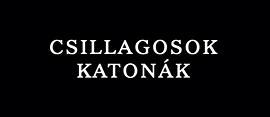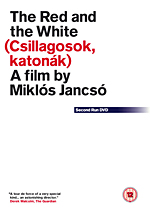 Csillagosok, katonák
Csillagosok, katonák
Hungary/USSR, 1967, black and white, 90 mins
Superficially, it’s easy to see why the Soviet Union thought that Miklós Jancsó would be the man to direct a Hungarian-Soviet co-production commemorating the October Revolution’s 50th anniversary. With My Way Home, made just eight years after the 1956 uprising, he’d portrayed a friendship between a Russian and a Hungarian. With The Round-Up he not only proved himself more than capable of handling large-scale set-pieces, but had also established himself as the most internationally reputable Hungarian director. And his proposed subject, the Hungarian revolutionaries who voluntarily backed the Bolsheviks, must have seemed like an ideal opportunity to commemorate Hungarian-Soviet relations.
In the event, though, the film’s Soviet co-producers were so disappointed with the end result that they banned its distribution in the USSR – and it’s not hard to see why. Firstly, Jancsó set the action in 1919, not 1917, a period of civil war and widespread confusion. Secondly, despite the film’s English title suggesting a clear delineation between Red (Bolshevik) and White (Tsarist) forces, in practice it is virtually impossible to distinguish between them. This was clearly intentional on Jancsó’s part, but it’s hardly the glorious endorsement of the Red side of the equation that his backers must have expected.

In fact, The Red and the White (whose Hungarian title translates literally as ‘Starry Soldiers’, or more colloquially as ‘Stars on their Caps’) is an entirely logical follow-up to The Round-Up in that it too offers a detached, clear-eyed presentation of the mechanics of oppressive power as applied in practice. The opening scenes echo those of both The Round-Up and My Way Home in that we see large numbers of people being repeatedly rounded up, stripped and summarily executed. The impression of anarchic chaos is established from the start by a map of eastern Europe with a bewildering profusion of arrows that presumably indicate troop movements. But with no context-setting or clarification other than the suggestion that Moscow is at the heart of events, it’s as mystifying as any of the film’s later battle scenes.
In a series of successive scenes, Hungarian supporters of the Red Army are rounded up by the Whites, interrogated and freed with the admonishment “This is our war”. Russians, by contrast, are summarily shot, often after being forced to run, the better to provide moving target practice. Groups of horsemen ride into the countryside, shooting at each other while rounding up partisans and innocent bystanders. The men are stripped of their weapons, while the women are stripped of their clothes and probably raped. All this is carried out so matter-of-factly that it’s almost as though the rural population has been collectively conditioned to have the same fatalistic reaction. Listen to the soundtrack divorced from the images, and all you’ll hear is birdsong (a characteristic Jancsó aural tic), barked Russian commands and occasional shots – but no cries or protests from the victims. Everyone seems to be going through the motions, with only occasional exceptions, such as the startling moment when a bare-chested Hungarian on foot successfully overpowers a White officer on horseback.

We eventually encounter another distinct group besides Red and White fighters when one of the Red escapees stumbles upon a field hospital and opportunistically lying on the ground amidst a group of bodies after having spotted that not all of them are dead. Shortly afterwards, the hospital’s nurses are rounded up by the Whites – but instead of the usual and expected humiliation and slaughter, they’re whisked off to a classically Russian silver-birch wood for an impromptu recreation of a ballroom dance, complete with live musicians playing a mournful waltz. This echoes the equally surprising appearance of the military band towards the end of The Round-Up, but the effect here is even more incongruously surreal: it’s as though the Whites (i.e. the more aristocratic side of the conflict) felt a deep-seated psychological need to try to recreate a more civilised (i.e. Tsarist) past with whatever paltry materials they had at their disposal. It also marks the point where Jancsó makes it clear that anyone in search of a conventional bit of revolutionary propaganda is wasting their time – was this the point where his Soviet backers shifted uneasily in their seats, or had they written the film off already?

And then it’s back to the war, with men and horses running for their lives as they’re buzzed by planes, though as soon as they leave, it’s business as usual: more rounding-up, singling-out and summary execution. Although people are frequently shot on camera at point-blank range, there is no blood: they merely fall down as though the rifles contained compressed air. This approach was near-universal in the days of the classic John Ford westerns that Jancsó acknowledges as one of his lifelong inspirations, but by 1967 it’s become stylised enough to be just as surreal as the “ballroom” scene. If I remember rightly, just one soldier seems to display any pain when he dies in close-up towards the end, though any emotional response is limited by the fact that we have little idea who he is – it seems purely coincidental that he happened to die right in front of the camera.
The psychological warfare, while not as chillingly sophisticated as in the more hermetic The Round-Up, is nonetheless ever-present. A huge crowd of white-shirted prisoners is herded into a square lined with arched colonnades, the Russians separated and freed, the Hungarians ordered to strip to the waist and given fifteen minutes to flee – straight into a dead end that was clearly created artificially for precisely this purpose. Having failed this blatantly rigged test, they are lined up and shot. Later, after a line of men has been vetting for courage under fire (by firing a gun into the air directly behind their heads to see if they flinch), a nurse is asked to pick the man she’d prefer to be shot by. People of both sexes are frequently ordered to remove their clothes – there’s considerably more nudity on display than there was in Jancsó’s earlier work, but it’s generally seen from a distance that’s not so much discreet as deliberately dehumanising.

Whereas The Round-Up threaded personal stories through the long-distance overview of intricate troop movements and military operations, this time round there’s very little to latch on to. Seasoned Jancsó viewers will doubtless recognise András Kozák (the Hungarian lead in My Way Home, a key supporting player in The Round-Up) as a Red who makes regular appearances throughout the film, including a final-shot close-up – but he’s just as archetypal as his anonymous colleagues. A romance between a soldier and a nurse is perfunctory enough to suggest that Jancsó is merely tossing his audience a generic bone, one of many pieces of evidence cited by Matt Johnson, in by far the most comprehensive analysis of the film that I’ve found online, in support of his thesis that The Red and the White can be read as a great anti-war satire that rivals Dr Strangelove in its skewed adoption and subversion of traditional war-movie clichés.
In terms of mise-en-scène, The Red and the White is as virtuosic as The Round-Up, with many set-pieces astounding in their scale and accomplishment – all the more so for coming across so casually, as though Jancsó had visited an actual o
ngoing conflict and merely decided to film the bits that best served his thesis about the confusion and pointlessness of war. Towards the end of the film, with minuscule stick figures being mown down in droves by even more minuscule opponents (almost certainly as near-invisible on the big screen as they are on a DVD), Jancsó seems to be anticipating the passionless mass slaughter of hi-tech modern warfare and computer games, the difference here being that no-one is bothering to keep score.
- Director: Miklós Jancsó
- Producers: Jenő Götz, András Németh, Kirill Sirjajev
- Screenplay: Gyula Hernádi, Miklós Jancsó, Luca Karall, Valeri Karen, Giorgi Mdivani
- Photography: Tamás Somló
- Production Design: Anatoli Burdo, Boris Chebotaryov, Ferenc Kopp
- Costume Design: Maya Abar-Baranovskaya, Gyula Várdai
- Editor: Zoltán Farkas
- Sound: Zoltán Toldy
- Cast: József Madaras (Hungarian Commander); Tibor Molnár (András); András Kozák (Lászlo); Jácint Juhász (István); Anatoli Yabbarov (Captain Chelpanov); Sergei Nikonenko (Cossack Officer); Mikhail Kozakov (Nestor); Bolot Bejshenaliyev (Chingiz); Tatyana Konyukhova (Yelizaveta the Matron); Krystyna Mikolajewska (Olga); Viktor Avdyushko (Sailor); Gleb Strizhenov (Colonel); Nikita Mikhalkov (White Officer); Vladimir Prokofyev; Valentin Bryleyev; Vera Bykova; Ye. Yermolayeva; Vitali Konyayev; Valeri Glebov; Yevgeni Karelskikh; Pyotr Savin; Nikolai Sergeyev; Sándor Szili; Roman Khomyatov; Károly Eisler; Mika Ardova; Valentina Berezutskaya; Gabi Daniel; Yelena Kozelkova; Nikolai Parfyonov; Nina Shorina; Natalya Zheromskaya

DVD Distribution: The Red and the White is available from Second Run (UK, PAL), Clavis (France, PAL) and Kino (US, NTSC) – I don’t think any releases are region coded, and all have English subtitles. This review is of the Second Run edition.
Picture: Comfortably the most disappointing of Second Run’s Jancsó releases, the anamorphic enhancement and correct 2.35:1 aspect ratio is scant compensation for a very soft image and interlaced transfer. The condition of the source print is similar to that of Second Run’s other Jancsós (i.e. very acceptable), so it’s hard to say if the problems derive from that or the transfer – though I get the impression that the other editions aren’t any better, suggesting a common source.
Sound: By contrast, the soundtrack is fine, and I’m quite happy to believe that it’s a perfect reflection of the 1967 mono original. Very faint hiss can be discerned if you turn the volume right up, but this has to be to uncomfortable levels to notice anything.
Subtitles: Typically for this label, the subtitles are white and optional, translating Hungarian and Russian dialogue alike. They’re less comprehensive than usual, but passages where prisoners are being herded by their captors are easy enough to work out from the context.
Extras: There are two extras, the first being the ‘Budapest’ episode of Jancsó’s 1994 television series Message of Stones (other episodes can be found on Second Run’s My Way Home and Clavis’ Red Psalm discs), the second being a booklet containing a long interview with Jancsó by Andrew James Horton that’s also available online – see links below.
Links
- Filmtörténet (in Hungarian, but with video clips)
- Internet Movie Database
- Surprisingly lengthy Wikipedia entry
- Matt Johnson’s extensive essay, ‘Paradoxical Phase: Miklós Jancsó and the Comedy of War’
- Reviews: Chicago Reader (Jonathan Rosenbaum); Daily Film Dose (Alan Bacchus); DVD Times (Gary Couzens); Eye For Film (Ben Sillis); MovieMartyr (Jeremy Heilman); Ozus’ World (Dennis Schwartz); Thirtyframesasecond (Kevin Wilson)
- Kinoeye’s excellent overview of Jancsó’s 1960s career briefly mentions The Red and the White, as does their interview with the director. The film is discussed in more detail in a separate piece about his fondness for the year 1919.
- Second Run’s page about their DVD.
- Kino’s page about their DVD.
- Second Run DVD available from: Amazon.co.uk; MovieMail, Play.com